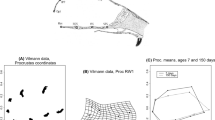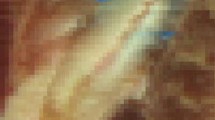Abstract
The current literature that attempts to bridge between geometric morphometrics (GMM) and finite element analyses (FEA) of CT-derived data from bones of living animals and fossils appears to lack a sound biotheoretical foundation. To supply the missing rigor, the present article demonstrates a new rhetoric of quantitative inference across the GMM–FEA bridge—a rhetoric bridging form to function when both have been quantified so stringently. The suggested approach is founded on diverse standard textbook examples of the relation between forms and the way strains in them are produced by stresses imposed upon them. One potentially cogent approach to the explanatory purposes driving studies of this class arises from a close scrutiny of the way in which computations in both domains, shape and strain, can be couched as minimizations of a scalar quantity. For GMM, this is ordinary Procrustes shape distance; in FEA, it is the potential energy that is stored in the deformed configuration of the solid form. A hybrid statistical method is introduced requiring that all forms be subjected to the same detailed loading designs (the same “probes”) in a manner careful to accommodate the variations of those same forms before they were stressed. The proper role of GMM is argued to be the construction of regressions for strain energy density on the largest-scale relative warps in order that biological explanations may proceed in terms of the residuals from those regressions: the local residual features of strain energy density. The method, evidently a hierarchical one, might be intuitively apprehended as a geometrical approach to a formal allometric analysis of strain. The essay closes with an exhortation.











Similar content being viewed by others
Notes
If any strain matrix has singular-value decomposition UDV t, U, V orthonormal and D diagonal, each 3 × 3, then the representation is (UDV t)(UDV t)t = UDV t VDU t = UD 2 U t.
References
Antoulas AC (2005) Approximation of large-scale dynamical systems. Society for Industrial and Applied Mathematics, Philadelphia
Bookstein FL (1991) Morphometric tools for landmark data: geometry and biology. Cambridge University Press, Cambridge
Bookstein FL (2006) My unexpected journey in applied biomathematics. Biol Theory 1:67–77
Bookstein FL (2009) Measurement, explanation, and biology: lessons from a long century. Biol Theory 4:6–20
Bookstein FL (2013) Reasoning and measuring: numerical inference in the Sciences. Cambridge University Press, Cambridge (in press)
Bookstein FL, Ward PD (2012) A modified Procrustes analysis for bilaterally symmetrical outlines, with an application to microevolution in Baculites. Paleobiology (submitted for publication)
Boresi AP, Chong K, Lee JD (2010) Elasticity in engineering mechanics, 3rd edn. Wiley, Hoboken
Brazier LG (1927) On the flexure of thin cylindrical shells and other “thin” sections. Proc R Soc Lond A 116:104–114
Carroll JD, Chang J-J (1970) Analysis of individual differences in multidimensional scaling via an n-way generalization of the “Eckart-Young” decomposition. Psychometrika 35:283–319
Cox PG, Fagan MJ, Rayfield EJ, Jeffery N (2011) Finite element modeling of squirrel, guinea pig and rat skulls: using geometric morphometrics to assess sensitivity. J Anat 219:696–709
Gower JC (1966) Some distance properties of latent root and vector methods used in multivariate analysis. Biometrika 53:325–338
Hanken J, Hall BK (1993) The skull, vol 3, functional and evolutionary mechanisms. University of Chicago, Chicago
Karamanos SA (2002) Bending instabilities of elastic tubes. Int J Solids Struct 39:2059–2085
Lieberman DE (2011) The evolution of the human head. The Belknap Press of Harvard University Press, Cambridge
McLaughlin P (2007) What functions explain: functional explanation and self-reproducing systems. Cambridge studies in philosophy and biology. Cambridge University Press, Cambridge
Mitteroecker PM, Bookstein FL (2009) The ontogenetic trajectory of the phenotypic covariance matrix, with examples from craniofacial shape in rats and humans. Evolution 63:727–737
Moussavi F (2009) The function of form. Actar and the Harvard University Graduate School of Design, New York
Nguyen CT-C (2007) EE C245 – ME C218, Introduction to MEMS design, Fall 2007, University of California at Berkeley. Lecture 16, Energy Methods. http://inst.eecs.berkeley.edu/~ee245/fa07/lectures/Lec16.EnergyMethods.pdf. Accessed 22 Feb 2012
O’Higgins P, Cobb SN, Fitton LC, Gröning F, Phillips R, Liu J, Fagan MJ (2011) Combining geometric morphometrics and functional simulation: an emerging toolkit for virtual functional analyses. J Anat 218:3–15
Sadd MH (2009) Elasticity: theory, applications, and numerics, 2nd edn. Academic Press, St Louis
Schaefer K, Mitteroecker P, Gunz P, Bernhard M, Bookstein FL (2004) Craniofacial sexual dimorphism patterns and allometry among extant hominids. Ann Anat 186:471–478
Schilders WHA, Vorst HA, Rommes J, (eds) (2008) Model order reduction: theory, research aspects and applications. Springer, Berlin
Segel LA (1977) Mathematics applied to continuum mechanics. Macmillan, New York
Strait DS, Weber GW et al (2009) The feeding biomechanics and dietary ecology of Australopithecus africanus. Proc Natl Acad Sci USA 106:2124–2129
Thompson D’AW (1917) On growth and form. Macmillan, New York
Todhunter I (1886) A history of the theory of elasticity and of the strength of materials. Cambridge University Press, Cambridge
Torgerson WS (1958) Theory and methods of scaling. Wiley, New York
Weber GW, Bookstein FL (2011) Virtual anthropology: a guide to a new interdisciplinary field. Springer, Vienna
Weber GW, Bookstein FL, Strait DS (2011) Virtual anthropology meets biomechanics. J Biomech 44:1429–1432
Witzel U, Preuschoft H (2005) Finite-element model construction for the virtual synthesis of the skulls in vertebrates: case study of Diplodocus. Anat Rec 283A:391–401
Acknowledgments
Preparation of this paper has been supported in part by National Sciences Foundation grant DEB–1019583 to the University of Washington (J. Felsenstein and F. Bookstein, PI’s). Some of the material has been presented previously at the Seventh Vienna Conference on Mathematical Modeling (Technische Universität Wien, February, 2012) and the 31st Leeds Annual Statistical Research workshop (University of Leeds, July, 2012). I am grateful to Gerhard Weber, University of Vienna, for the original invitation to argue an earlier version of these themes at the 2010 meeting he chaired, and to Paul O’Higgins for helping me to clarify the assumptions governing the conventional approach that I am criticizing here. The presentation here has benefitted greatly from comments by Philipp Mitteroecker, Department of Theoretical Biology, University of Vienna, and Jim Rohlf, Stony Brook University, as well as two anonymous reviewers for Biological Theory.
Author information
Authors and Affiliations
Corresponding author
Rights and permissions
About this article
Cite this article
Bookstein, F.L. Allometry for the Twenty-First Century. Biol Theory 7, 10–25 (2013). https://doi.org/10.1007/s13752-012-0064-0
Received:
Accepted:
Published:
Issue Date:
DOI: https://doi.org/10.1007/s13752-012-0064-0




